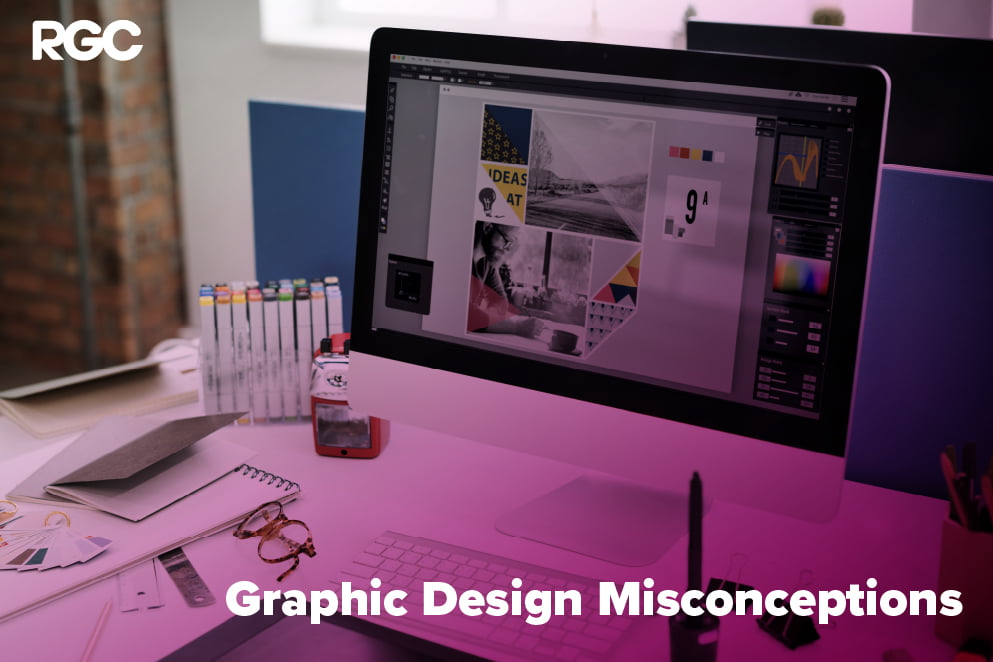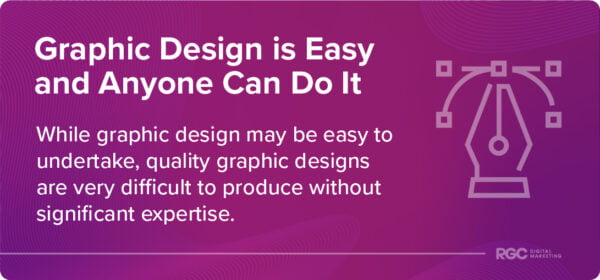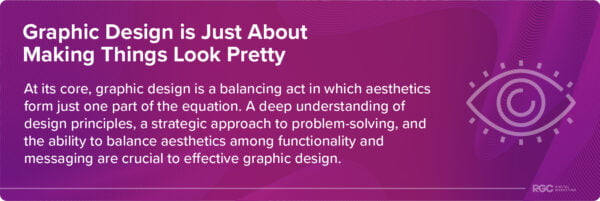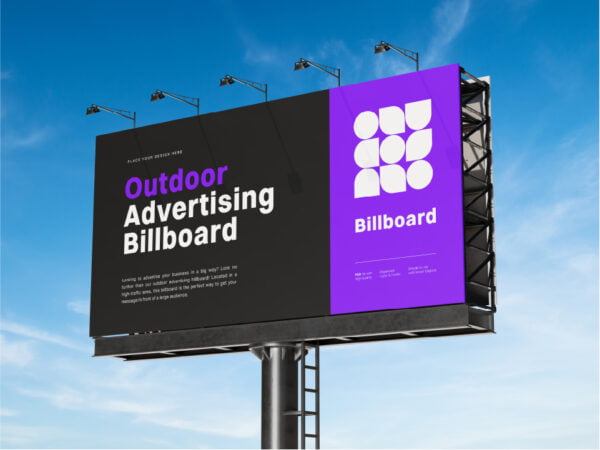Debunking the Top Graphic Design Myths: Uncovering the Truth for Creatives Everywhere

Table of Contents
- Myth 1: Graphic Design is Easy and Anyone Can Do It
- Technical Expertise and Creativity
- There’s No Substitute For Experience
- Examples To Consider
- Myth 2: Graphic Design is Just About Making Things Look Pretty
- Graphic Design Works to Solve Problems
- Aesthetics Alone Won’t Cut It
- Myth 3: Graphic Designers Only Work with Computers
- Physical Mediums Remain Pivotal
- Factors To Consider
- Myth 4: A Designer's Job Is Done Once the Design is Approved
- Collaboration Is Crucial
- Revisions and Criticism Are Essential
- Myth 5: Graphic Designers Are Not Strategic Thinkers
- Strategy Always Informs Design
- Quality Solutions Resonate With the Audience
-

- Myth 6: Graphic Design is Just About Following Trends
- Originality and Clarity Outperform Trends
- Collaboration Is Key
- Myth 7: Graphic Design is a Dying Industry
- Effective Designs Are Crucial In the Digital Age
- New Technologies Broaden Opportunities
- Myth 8: Graphic Design Work is Solely an Individual Effort
- Price Is a Product Of Many Factors
- You Get What You Pay For
Welcome to the world of graphic design, where creativity and technical skill meet to deliver quality visual solutions that shape our perceptions. It’s a field that’s often misunderstood, and as a result, is marred by many myths and misconceptions. Many believe it to be an easy profession that anyone can do, and think it is simply focused on beautifying logos. It’s often thought that graphic designers only work with computers and that their work is repetitive and lacks creativity. If any of these common graphic design myths sound familiar to you, you’re not alone.
In our visually-driven world, graphic design plays an essential role in shaping our perceptions and influencing our decisions. From logos to websites, packaging to billboards, every aspect of graphic design is carefully crafted to communicate a message, evoke emotions, and inspire action. However, the myths of graphic design can lead to a lack of appreciation for the profession and can even discourage businesses from employing graphic designers.
That’s where we come in. Our goal is to debunk the top graphic design myths and provide clarity on what it truly means to be a graphic designer. We’ll share our expert insights and thorough understanding of the industry to explore the many facets of graphic design and how they contribute to enhancing businesses. By the end of this article, you’ll have a better understanding of the profession, its importance, and the truth behind the graphic design myths. Let’s get started!
Myth 1: Graphic Design is Easy and Anyone Can Do It
One of the most common myths about graphic design is that it’s an easy profession that anyone can succeed in. While it’s true that everyone has some degree of creativity, becoming a successful graphic designer requires a unique blend of creativity and technical skills. Let’s take a closer look at why graphic design is more than just a creative hobby.
Technical Expertise and Creativity
Graphic design is all about problem-solving through visual communication. The best graphic designers have a deep understanding of colour theory, typography, composition, and other design elements that help them create effective visual solutions. Beyond that, they also benefit from a keen sense of creativity to develop unique and innovative design concepts that stand out in a crowded visual landscape.
There’s No Substitute For Experience
While creativity and technical skills are essential to graphic design, they can only take you so far. Professional training and experience are critical to developing a deep understanding of design principles and techniques. Real-world industry exposure to creating customised visual designs for businesses provides a strong foundation for a successful career in the industry.
Examples To Consider
To truly understand the difference between professional and amateur graphic design, you only need to look at some of the most well-known businesses in our world. Take, for instance, the logos of major brands such as Nike, Apple, and Coca-Cola. These logos are not only aesthetically pleasing, but they effectively communicate the brand’s values and messaging in a clear and bespoke manner. On the other hand, amateur logos may lack a clear concept, be visually unappealing, and fail to effectively communicate the brand’s identity.

Myth 2: Graphic Design is Just About Making Things Look Pretty
Another common myth about graphic design is that it’s all about making things look pretty. While aesthetics are certainly an important aspect of design, the role of graphic design goes far beyond creating visually appealing artwork. Let’s explore why.
Graphic Design Works to Solve Problems
At its core, graphic design is about using visual communication to solve problems. Designers must use a number of technical elements and considerations to convey a message or solve a specific problem. Whether it’s designing a website that’s easy to navigate, creating a logo that effectively represents a brand, or a poster that catches the viewer’s attention, graphic design requires a deep understanding of design principles and a strategic approach to problem-solving.
Aesthetics Alone Won’t Cut It
We’ve all seen advertisements that have caught our attention, but they’ve left us wondering what the advertisement was actually for. These advertisements might be remembered, but if the business itself is forgotten, it’s a waste of time for all involved. This is because even though aesthetics are important in graphic design, they must be balanced with functionality and messaging.
A design must not only look good but also serve its intended purpose and communicate a message effectively. A keen sense of creativity, a deep understanding of design principles, and the ability to think critically and strategically about each design are required to consistently create quality designs. Graphic designers must consider the target audience, the message they want to convey, and the best way to convey that message visually.

Myth 3: Graphic Designers Only Work with Computers
Another common myth about graphic design is that it’s an entirely computer-based profession. While technology has revolutionised the field and graphic design has an important role in digital marketing, graphic designers also work with a variety of physical mediums too. Let’s explore how graphic designers go beyond digital means to create compelling and effective designs.
Physical Mediums Remain Pivotal
Graphic designers have a wide range of mediums to work with beyond digital assets, such as print materials, signage, packaging, and merchandise. These physical products often require a different set of design considerations, such as size, material, and usage environment. For instance, designing a billboard requires an understanding of how to effectively communicate a message to a large audience at a distance, while packaging design needs to account for how a product will be viewed on a shelf.

Factors To Consider
In each of these mediums, graphic designers must take into account unique factors that affect the design, including the physical limitations of the medium, the intended audience, and the design’s purpose. By understanding the nuances of each physical medium, graphic designers can create designs that are visually appealing, effective, and appropriate for their intended use.

Myth 4: A Designer’s Job Is Done Once the Design is Approved
One of the most common myths about graphic designers is that their job is finished once the design is approved. In reality, graphic designers play an ongoing and vital role in project management, collaboration, revisions, and execution. Let’s take a closer look at why the designer’s work is never truly done.
Collaboration Is Crucial
Graphic designers often work as part of a team, collaborating with clients, project managers, copywriters, and other professionals. Effective project management and collaboration are critical to the success of a design project. A graphic designer must be able to communicate effectively with team members, manage their time and resources effectively, and provide regular updates on their progress.
Revisions and Criticism Are Essential
A design project rarely goes smoothly without any revisions or feedback. Graphic designers must be able to take constructive criticism and feedback from team members and clients and use it to improve their work. Additionally, a designer must be able to execute the design accurately, making sure that the final product meets the project’s requirements. As a result, the ongoing responsibilities of a graphic designer can vary, and often they are centred around meetings that clarify project requirements and regular collaboration with team members to seamlessly blend text, design and development.

Myth 5: Graphic Designers Are Not Strategic Thinkers
One of the most persistent myths about graphic designers is that they are only focused on the visual aspects of a project and do not have a strategic mindset.
Strategy Always Informs Design
In reality, graphic designers play an important role in strategic thinking by connecting design to marketing objectives, understanding the target audience and competition, and delivering results through strategic design solutions.
Design is a critical component of any marketing campaign, and graphic designers must understand the objectives of the campaign in order to create effective designs. This requires a strategic mindset and the ability to understand how design can influence consumer behaviour and perceptions.
Quality Solutions Resonate With the Audience
Graphic designers must have a deep understanding of the target audience and the competition to create designs that resonate with consumers and stand out in a crowded marketplace. By conducting research and analysing data, designers can develop insights into consumer behaviour and preferences, and use this knowledge to inform their designs.
Myth 6: Graphic Design is Just About Following Trends
One of the persistent myths about graphic design is that it is solely about following trends. However, graphic design is a creative field that requires a unique blend of technical skills and creativity to produce successful designs.
Originality and Clarity Outperform Trends
While trends can inspire and inform design choices, graphic designers must have a keen sense of originality and creativity to develop unique and innovative design concepts. Graphic design is all about balancing aesthetics, functionality, and messaging. A design that is visually stunning but lacks a clear message or is difficult to read is not an effective design. Similarly, a design that is highly functional but aesthetically unappealing is unlikely to resonate with consumers. Successful graphic design requires finding the right balance between these elements and creating designs that effectively communicate the intended message.
Collaboration Is Key
A deep understanding of the specific purpose and goals of the project is always needed, and trending designs can never substitute close and careful collaboration with clients and stakeholders. This ensures that the design meets business objectives and effectively communicates the intended message.
While trends can inform design choices, graphic design is a creative and diverse field that requires originality, creativity, and a deep understanding of the balance between aesthetics, functionality, and messaging. By embracing these elements and designing with purpose, graphic designers can create work that is both visually appealing and effective in achieving business objectives.

Myth 7: Graphic Design is a Dying Industry
Despite the rapid advancements in AI and the rise of DIY design tools, the myth that graphic design is a dying industry couldn’t be further from the truth. In fact, graphic design continues to be a critical component of many industries, with growing demand for visual content in the digital age.
Effective Designs Are Crucial In the Digital Age
As more businesses move online and social media becomes increasingly prevalent, the need for high-quality visual content has never been greater. From website design to social media graphics to email marketing campaigns, businesses rely on graphic designers to create compelling visual content that engages and resonates with their target audience.
New Technologies Broaden Opportunities
With the rise of new technologies like virtual reality, augmented reality, and artificial intelligence, graphic designers are presented with exciting new opportunities to create innovative and engaging visual content. Additionally, there is a growing demand for designers who specialise in specific areas, such as UX design, motion graphics, and branding.
As the industry continues to evolve, graphic designers will need to stay up-to-date with emerging technologies and trends to remain competitive. However, the fundamentals of graphic design will always remain essential, including a deep understanding of colour theory, the impact of font, and the importance of sound composition.

Myth 8: Graphic Design Work is Solely an Individual Effort
One of the most common myths in the world of graphic design is that simple designs are always cheaper. However, this is not always the case. While simple designs are less time-consuming to create, the cost of a design is determined by a variety of factors beyond its complexity.
Price Is a Product Of Many Factors
The cost of a design project is determined by the project scope and requirements. This includes the size and complexity of the project, the number of deliverables required, and the timeline for completion. A simple design that requires a quick turnaround or a large number of deliverables may be more expensive than a more complex design that is less time-sensitive or requires fewer deliverables.
You Get What You Pay For
Another factor that can affect the cost of a design project is the experience and expertise of the designer. More experienced designers may be able to create more complex designs more efficiently, resulting in a lower cost for the client. On the other hand, a less experienced designer may require more time to create a simple design, resulting in a higher cost for the client.

Graphic design is a dynamic profession that goes beyond just making things look pretty. It requires a unique blend of creativity, technical skills, and a strategic mindset to create effective designs that solve problems and communicate messages. Despite common myths and misconceptions, the demand for graphic design continues to grow in the digital age, with new technologies providing exciting opportunities for innovation and growth.
It is a constantly evolving industry that requires designers to stay up-to-date with emerging trends and technologies while maintaining a strong foundation in design fundamentals. By understanding the truth behind the myths, you can be confident in enlisting the services of experienced graphic designers that can provide quality customised solutions each and every time.


